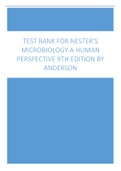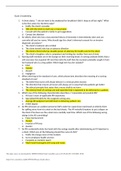TEST BANK FOR NESTER’S
MICROBIOLOGY A HUMAN
PERSPECTIVE 9TH EDITION BY
ANDERSON
0
Copyright © 2019 McGraw-Hill Education. All rights reserved.
No reproduction or distribution without the prior written consent of McGraw-Hill Education.
,Nester’s Microbiology, 9e (Anderson)
Chapter 1 Humans and the Microbial World
1) The scientist usually considered the first to see microorganisms, which he called
"animalcules," was ________.
A) Redi
B) van Leeuwenhoek
C) Pasteur
D) Tyndall
Answer: B
Section: 01.01
Topic: History of Microbiology
Bloom's: 1. Remember
Learning Outcome: 01.01 Describe the key experiments of scientists who disproved spontaneous
generation.
ASM Objective: 02.01 The structure and function of microorganisms have been revealed by the
use of microscopy (including bright field, phase contrast, fluorescent, and electron).
2) The word "animalcule" was first used by ________.
A) Pasteur
B) Redi
C) van Leeuwenhoek
D) Tyndall
E) Hooke
Answer: C
Section: 01.01
Topic: History of Microbiology
Bloom's: 1. Remember
Learning Outcome: 01.01 Describe the key experiments of scientists who disproved spontaneous
generation.
ASM Objective: 02.01 The structure and function of microorganisms have been revealed by the
use of microscopy (including bright field, phase contrast, fluorescent, and electron).
3) The idea of spontaneous generation postulated that
A) organisms could evolve into the next generation of organisms.
B) organisms could spontaneously turn into other types of organisms.
C) living organisms could spontaneously arise from non-living material.
D) living organisms could spontaneously arise from other living organisms.
E) living organisms must contain at least ten cells.
Answer: C
Section: 01.01
Topic: History of Microbiology
Bloom's: 2. Understand
,Learning Outcome: 01.01 Describe the key experiments of scientists who disproved spontaneous
generation.
ASM Objective: 02.01 The structure and function of microorganisms have been revealed by the
use of microscopy (including bright field, phase contrast, fluorescent, and electron).
4) Which of these scientists were involved in investigating the idea of spontaneous generation?
A) Redi and van Leeuwenhoek
B) Redi and Pasteur
C) van Leeuwenhoek and Pasteur
D) Pasteur and Escherich
E) Escherich and Redi
Answer: B
Section: 01.01
Topic: History of Microbiology
Bloom's: 2. Understand
Learning Outcome: 01.01 Describe the key experiments of scientists who disproved spontaneous
generation.
ASM Objective: 02.01 The structure and function of microorganisms have been revealed by the
use of microscopy (including bright field, phase contrast, fluorescent, and electron).
5) The work of Tyndall and Cohn
A) supported the idea of spontaneous generation rather than the idea of biogenesis.
B) explained why some spontaneous generation investigators got different results from those of
Pasteur.
C) showed that all microbes caused disease if they enter the human body.
D) allowed scientists to see microorganisms using a simple microscope.
E) showed that boiling fails to kill vegetative bacteria.
Answer: B
Section: 01.01
Topic: History of Microbiology
Bloom's: 3. Apply
Learning Outcome: 01.01 Describe the key experiments of scientists who disproved spontaneous
generation.
ASM Objective: 02.03 Bacteria and Archaea have specialized structures (e.g., flagella,
endospores, and pili) that often confer critical capabilities.; 02.01 The structure and function of
microorganisms have been revealed by the use of microscopy (including bright field, phase
contrast, fluorescent, and electron).
6) The structures present in the hay infusions used in experiments on spontaneous generation
that made them difficult to sterilize are A) chloroplasts.
B) endospores.
C) organelles.
D) toxins.
E) nuclei.
, Answer: B
Section: 01.01
Topic: History of Microbiology
Bloom's: 1. Remember
Learning Outcome: 01.01 Describe the key experiments of scientists who disproved spontaneous
generation.
ASM Objective: 02.03 Bacteria and Archaea have specialized structures (e.g., flagella,
endospores, and pili) that often confer critical capabilities.; 02.01 The structure and function of
microorganisms have been revealed by the use of microscopy (including bright field, phase
contrast, fluorescent, and electron).
7) The contradictory results obtained by different scientists apparently doing the same
experiments in investigating spontaneous generation
A) show that experiments should only be done once.
B) show the importance of exactly duplicating experimental conditions.
C) led to further experiments that ultimately proved spontaneous generation.
D) could not be explained by anyone involved in the work.
E) led to the development of swan-necked flasks.
Answer: B
Section: 01.01
Topic: History of Microbiology
Bloom's: 3. Apply
Learning Outcome: 01.01 Describe the key experiments of scientists who disproved spontaneous
generation.; 01.03 Describe the scientific method, using Pasteur's swan-necked flask experiment
as an example.
ASM Objective: 02.03 Bacteria and Archaea have specialized structures (e.g., flagella,
endospores, and pili) that often confer critical capabilities.; 02.01 The structure and function of
microorganisms have been revealed by the use of microscopy (including bright field, phase
contrast, fluorescent, and electron).
8) If Pasteur had done his experiments investigating spontaneous generation in a horse stable,
A) the results would probably have supported the idea of spontaneous generation.
B) the results would probably not have supported the idea of spontaneous generation.
C) the results would probably been the same as those obtained in a laboratory.
D) the results would probably have supported the idea of spontaneous biogenesis.
E) it would probably have taken several years to obtain any results.
Answer: A
Section: 01.01
Topic: History of Microbiology; Prokaryotes
Bloom's: 3. Apply
Learning Outcome: 01.01 Describe the key experiments of scientists who disproved spontaneous
generation.; 01.03 Describe the scientific method, using Pasteur's swan-necked flask experiment
as an example.
ASM Objective: 02.03 Bacteria and Archaea have specialized structures (e.g., flagella,
endospores, and pili) that often confer critical capabilities.; 02.01 The structure and function of





